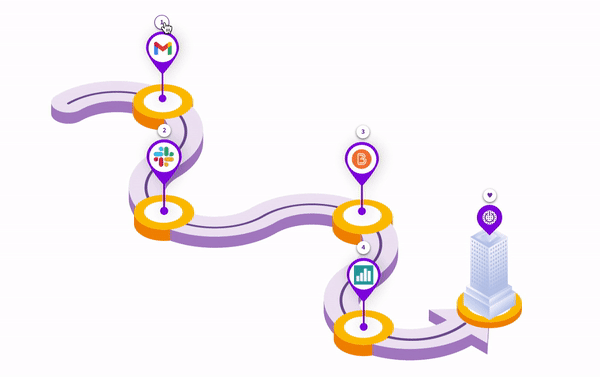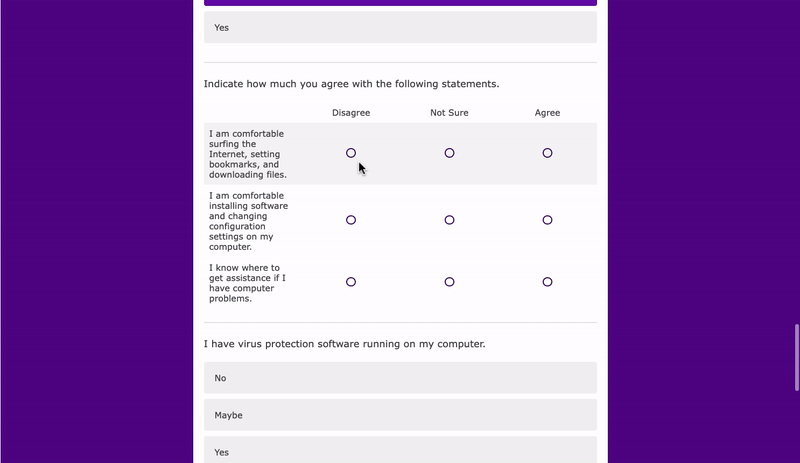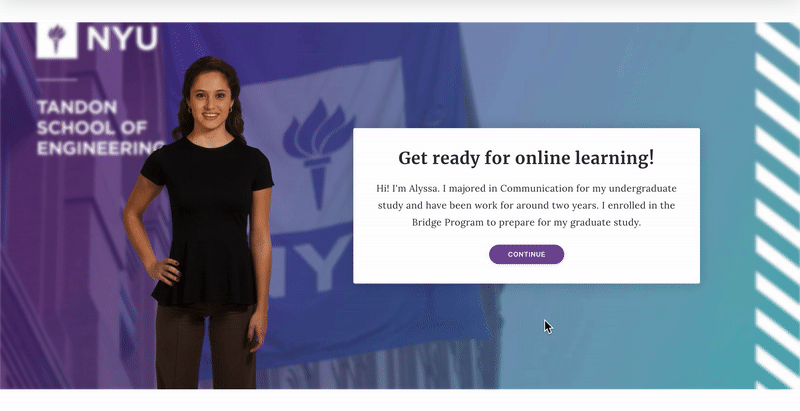Yi Lu
The Bridge Program Orientation
.png)
Updating the Bridge Program online orientation courses to improve students' online learning readiness in social, technical, and learning domains.
Duration
Team
Jun 2022 - Dec 2022
Yuhan Tan
My Role
Tools Used
Instructional Designer
Project Manager
Rise 360, Storyline, Canva, Premiere, Photoshop, Illustrator
Project Overview
The Bridge Program is an online program at NYU Tandon Online. It was developed to build foundational skills in those without a technical background in order to prepare for applying to select STEM graduate programs at NYU. Students are distance adult learners with various backgrounds and prior knowledge, who can face a lot of challenges. To prepare students for the online learning journey, required by Tandon Online, our team updates the old version of the self-directed orientation courses of the Bridge Program with Rise 360 to improve students' online learning readiness.
The old version of the orientation course

Problems
Lack of Engagement
The visual and narrative designs are hard for students to engage in and feel relevant. Students may quickly skip through the content without paying attention.
Lack of Cognitive Load Management
A significant amount of information without chunking will hinder learners from managing working memory, The adult learners' strong ability of self-reflection can also be better taken advantage of to increase the generative cognitive process.
Learning Design Solutions
Increase Engagement
1. Alumni sharing their personal experience
We invite the alumni to be the course presenter and share their hindsight and reflections. Their personal stories let students know that alumni have experienced similar challenges and challenges are surmountable. Students will feel relevant to the content when listening to their peers' personal stories so that they are more likely to value it and act upon it.
2. Visual Design and User Interface Design
Rise 360 provides a high degree of usability so that minimizes the effort a learner needs by providing straightforward navigation.
Considering adult learners have some limitations, e.g. short-term memory decreases with age, we use large, easy-to-read fonts and bold colors. We turn on the navigation and allow learners to search content so that learners can control the learning progress by themselves. We also optimize the visual design as the appealing pages increase the time the learner spends on the page. For example, the default horizontal layout of Rise 360 can be boring, so we use curves to add some fluidity and vitality to the page.
Color Palette


3. Gamification
Learners are going to embark on an online learning adventure, where they are supposed to finish all the modules and knowledge checks for how to use Google Apps, Slack, Brightspace, and Gradescope. Those who finish the course can view suggestions for incoming students from alumni, which serve as intrinsic rewards that incentivize learners to finish the course.

Improve Cognitive Presence
1. Problem-centered Learning Activities
As adults are more goal-oriented and want to know why they should learn something and how it will benefit them, we design a couple of problem-centered learning activities.
Interactive widgets
Pre-built interactive widgets in Rise 360 such as Flashcards, labeled graphics, and sorting activities create friction and attract learners' attention.




Simulated Technology Exercises
We created simulated technology exercises in Storyline to help learners practice technology tools such as Brightspace, Google Drive, and Gradescope in a realistic setting. Then we embedded Storyline widgets into Rise 360. Different kinds of hints are provided for scaffolding, for example, on learners' first incorrect attempt, hints appear in the dialogue box, then a more direct hint (an arrow that points to the right spot) appears on their third incorrect attempt.




Self-Assessment
We embedded an online learning readiness self-assessment survey at the beginning of the course. As adult learners are self-directed and with different prior experiences. We'd like to use self-assessment to activate their prior knowledge and have them aware of how much online learning can change their lifestyle so that they know why they need to learn this. The survey will provide recommendations based on learners' input.

Real-life Scenarios
We created real-life scenarios at the beginning of each module to activate learners' prior knowledge as pre-training. These virtual characters are peers who might have the same background with learners. They are struggling with online learning and learners are supposed to help them solve the problem with their knoweldge. With a conversational language style, students will be more likely to engage in it.

2. Multimedia Learning Principles
We followed multimedia learning principles to minimize extraneous processing, manage essential processing and increase generative process.
-
Contiguity Principle
-
Redundancy Principle
-
Segmenting Principle
-
Pre-training Principle
-
Modality Principle
-
Personalization Principle
-
Voice Principle












